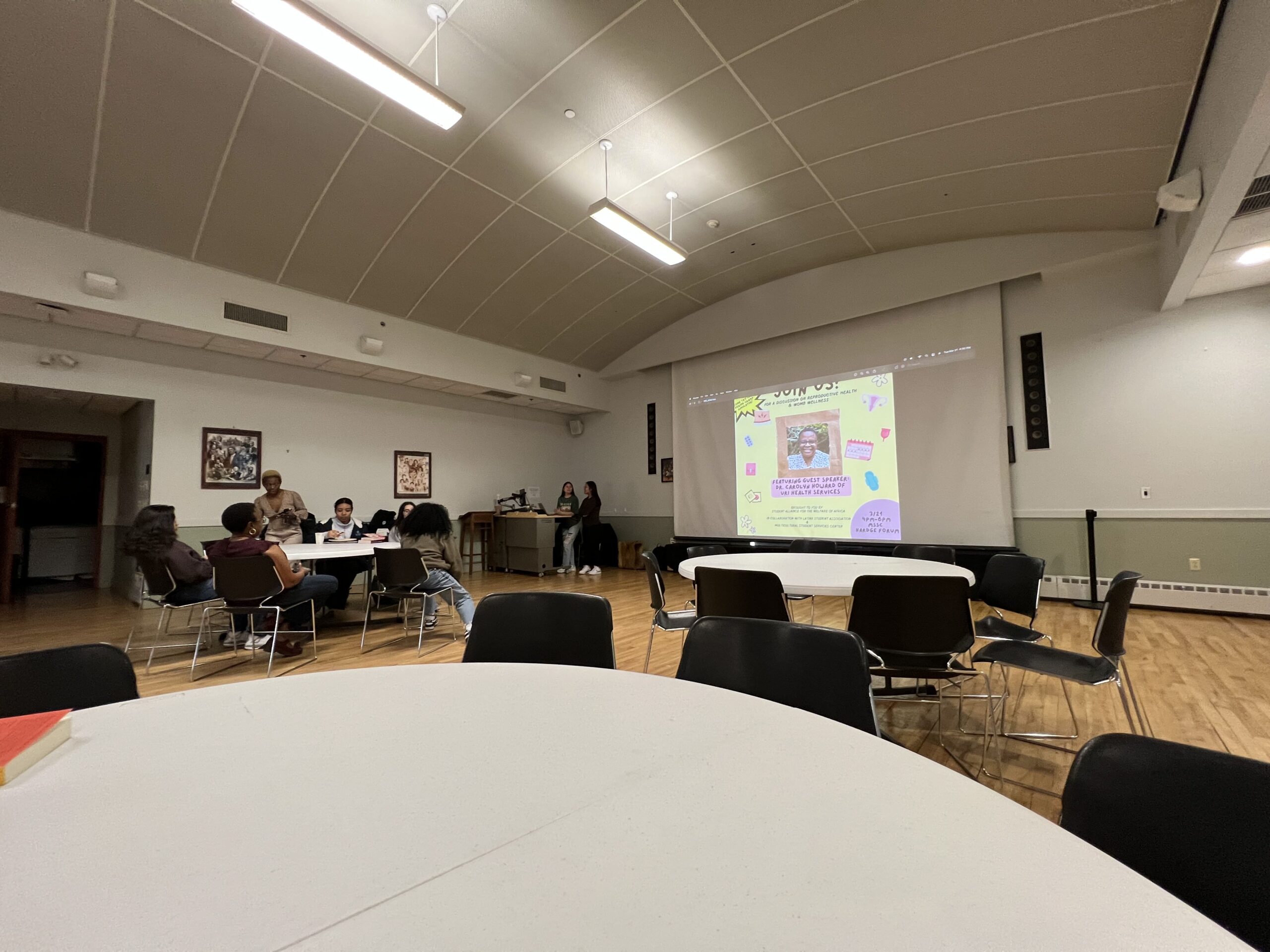Pictured: Discussion on reproductive health and wellness held at MSSC. PHOTO CREDIT: Ryan Estus | Contributing Reporter
The University of Rhode Island’s Multicultural Student Services Center held an event titled “A Discussion on Reproductive Health & Womb Wellness” on Tuesday, March 21, which focused on the Black women whose bodies were used to build the field of Obstetrics and Gynecology without acknowledging their role.
The event was hosted by Dr. Carolyn Howard, a gynecology consultant for URI’s Health Services department.
Born in Washington, D.C, and raised in the South-American country of Guyana, Howard spent her early years there before traveling back to the US to attend York College of New York, as well as Johns Hopkins in Maryland and the University of Pennsylvania for her graduate studies.
In her current position in Health Services, Howard is passionate about educating others on the fields of Gynecology and sexual health, but understands that the field of medicine she comes from, and the treatment towards black patients, isn’t what it should be.
“There’s a lot of complaints [from black patients] about how doctors don’t listen, we don’t have enough time,” said Howard, who herself is Afro-Caribbean, “but that’s part of the system I trained under. It’s not going to take black doctors to fix this, it’s going to take changing the system, and understanding where these biases come from.”
The main topic of the event was a group of 19th-century women known as the “Mothers of Gynecology,” who received their name due to constantly undergoing experimental surgeries and serving as nurses to doctors who would experiment different surgical techniques.
One of the many women who was experimented upon, and a large topic in Dr. Howard’s presentation was named Sarah Baartman. Born with the name of Ssehura as a member of the Khoikhoi, a nomadic population indigenous to southwestern Africa, she grew up on European farms before moving to Cape Town, South Africa. Baartman became a topic of significant interest, due to having substantial amounts of body tissue on her buttocks and thighs, known as “steatopygia.”
It was in Cape Town that she came into contact with two men, Hendrick Cesars and surgeon Alexander Dunlop, who encouraged her to go to Europe to exhibit herself for money.
According to an article on the topic by ABC News, the group ended up moving to London, England in 1810, where Baartman was put on display in the famous Piccadilly Circus.
During her time on display in London, she began to draw scientific attention due to her unique body composition, although some of it pertained to racial bias as well as erotic projections. She was marketed, according to Dr. Natasha Gordon-Chipmembere, as being “the missing link between man and beast.”
After being sent on a tour around Europe, where she was brought out as an exhibit to wealthy people’s parties and events, Baartman passed away on Dec. 29, 1815, at 26 years old. French naturalist and founder of the discipline of comparative anatomy Georges Cuvier conducted Baartman’s autopsy, removing organs such as the brain, genitalia and skeleton in the process to be further preserved.
Baartman’s skeleton and body cast were later displayed in the Natural History Museum in Angers, France, before being moved to the Musée de l’Homme in 1937, an anthropological museum in Paris where they remained before the skeleton was eventually taken down in 1974, with the body cast shortly after in 1976.
Apart from Dr. Howard’s presentation, another key feature of the event was the deployment of a ‘period-cramp simulator,’ which used electromagnetic pulses to stimulate abdomen muscle contractions, hence replicating a period cramp.
The tests were done on two different individuals, one male and one female, sitting across from one another in chairs. As the electrode pads were placed on the abdomen, and were gradually turned up in intensity, the male subjects were noticeably uncomfortable, even occasionally reduced to fits of yelling and squirming, while the female subjects were calm and unbothered by the electric stimulation.
Overall, Baartman has been remembered as having an influential role in the development of the gynecology practice. In 2021, the Mothers of Gynecology monument was unveiled in Montgomery, Alabama, near the National Memorial for Peace and Justice, which serves to remember the victims of black lynchings in the United States.
The monument consists of 3 women, Anarcha Westcott, and two women simply named Betsey and Lucy, who were enslaved women and patients of controversial doctor and the “father of gynecology,” J. Marion Sims, whose practices of surgical procedures on enslaved women, without anesthesia, are becoming increasingly condemned.
The statues were made from discarded metal objects, with some being contributions from the public as requested by the artist, Michelle Browder, and were made “to symbolize how Black women have been treated and to demonstrate the beauty in the broken and discarded.”

